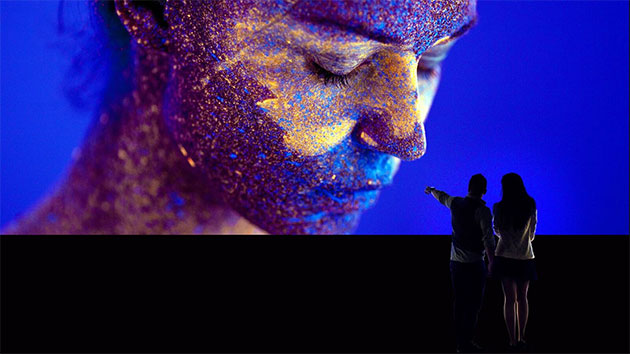Tiny, Surface-Mounted Light Sources and Black Background Are the Breakthrough in This High-Contrast Technology
Sony is set to unveil Canvas, a new type of display technology, at InfoComm this year.
Canvas uses surface-mounted light sources that Sony is calling Ultrafine LEDs, to drive large, high-contrast and HDR-ready displays. Canvas is rated at 1,000 nits of brightness and runs at a full 120Hz, displaying 140% of sRGB color space with 10-bit color depth. Sony intends the display for "public spaces and high-end visual entertainment," said Sony Electronics VP of B2B Sales and Marketing Theresa Alesso. The company said it expects adoption in theme parks, museums, corporate environments, broadcast studios, and industrial design and manufacturing.
In its Infocomm booth, Sony will show an 8Kx2K Canvas display measuring 32 feet by nine feet — about twice the size and four times the resolution of what the company has shown in previous years, according to Kevin O'Connor, senior manager, sales and marketing, visual simulation and entertainment, Sony Electronics. "It is a major leap forward versus what has been part of that market, be it narrow-bezel panels, LED walls or tiled display systems," O'Connor told StudioDaily. "This is truly a different technology altogether."
Ultrafine LEDs measure just .003 square mm in size, or about 1/100th the size of a conventional LED, O'Connor said. Those tiny LEDs are clustered in threes (one red, one green and one blue) on a Canvas unit, leaving more than 99 percent of the display's surface area completely and uniformly black. "Each of those pixels emits light independently, so we're able to control color, but because the rest of that surface area is black, we're able to produce incredible contrast on that display," O'Connor said. "Because the pixels are so tiny, you have to get up within inches of the wall to see them. And any which way you look at this thing, from top, bottom, left or right, you're going to see the same picture. The colors don't shift with this technology."
Individual Canvas panels measure 18 inches by 16 inches and have no bezels so they can be combined seamlessly to scale up to any practical size, Sony said. Each display unit sports 360×320 pixels, meaning the resolution of a Canvas display is determined by how many panels it uses. The 8Kx2K display at InfoComm will be 32 feet by 9 feet and will incorporate 144 units, but a 4Kx2K display would be 16 feet by 9 feet and incorporate 72 units, while an 8Kx4K display would be 32 feet by 18 feet and require 288 units. A Canvas display controller will be required to convert a video input for display on the multiple panels.
Sony isn't setting prices yet, but expect Canvas to come at a premium when it eventually ships at the end of 2016 or the beginning of 2017. "A lot of time and effort has gone into this," O'Connor said. "We feel it is a revolutionary large-display technology, and it will be priced accordingly."
Sony's Canvas display is set to make its public debut in the Sony booth at InfoComm 2016, scheduled for June 8–10 in Las Vegas, NV.
Did you enjoy this article? Sign up to receive the StudioDaily Fix eletter containing the latest stories, including news, videos, interviews, reviews and more.










